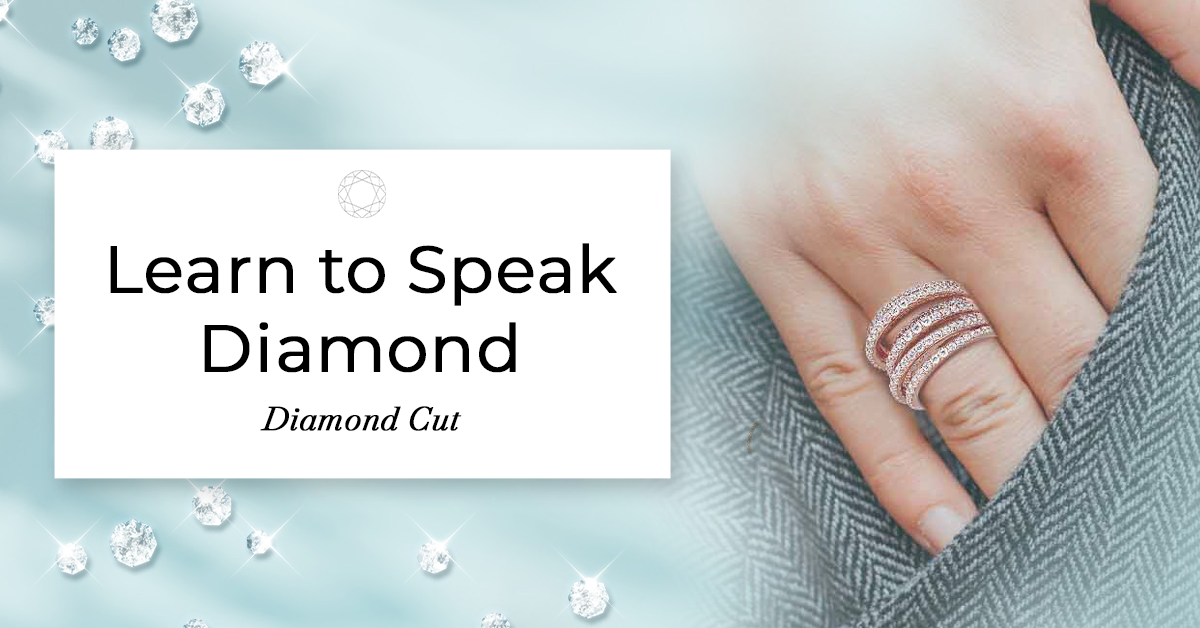
What do you call a diamond that hasn’t been cut properly? A rough diamond. Okay, okay, don’t roll your eyes. I know it was a cheesy joke, but I just had to add some humour before diving into the serious topic of diamond cuts. If you’re a fan of diamonds, you’re in for a treat as I will be exploring the world of diamond cuts, their importance, grading system, and the different types of diamond cuts.
In This Article:
Is Diamond Shape and Diamond Cut the Same?
The Importance of Diamond Cut
What is the Brilliance of a Diamond?
What is the Fire of a Diamond?.
What is the Scintillation of a Diamond.
Characteristics That Impact Diamond Cut.
How Different Parts of a Diamond Affects it’s Sparkle
Different Diamond Cut Grades
The Bottom Line
FAQ’s on Diamond Cuts
Summary
As I explained in my previous blog, although used interchangeably, a diamond shape and diamond cut are two very different aspects of a diamond. Diamond shape refers to the physical outline or form of a diamond. Diamond cut, on the other hand, refers to a diamonds proportions, symmetry and finish all of which are critical to maximizing the scintillation, fire and brilliance of a diamond. An excellent cut diamond refracts light in a way that maximizes its beauty and value while a poor cut diamond will look dull and cloudy as it has not been optimized to refract light
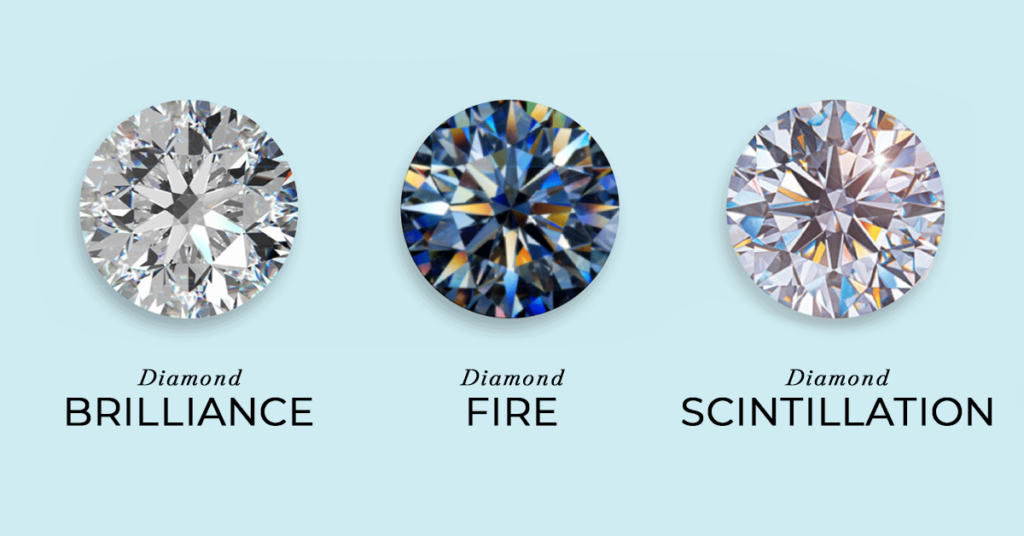
When it comes to diamonds, the cut is arguably the most important characteristic. The cut refers to how well the diamond has been shaped and polished from its rough state to create a diamond that maximizes its brilliance, fire, and scintillation – 3 words that are of extreme importance when buying a diamond because the way a diamond is cut impacts how it interacts with light, which determines its overall beauty and value.
. This is what we refer to as a diamond’s brilliance. Fire, on the other hand, refers to the rainbow of colours that are created as light enters and exits the diamond. Lastly, scintillation is the sparkling effect that is produced when the diamond is moved or when the light source is shifted.
| Diamond Shape | Ideal Table Percentage | Ideal Depth Percentage |
|---|---|---|
| Round Brilliant Cut | 54 to 57% | 59 to 62.6% |
| Princess Cut | 69 to 75% | 68 to 74% |
| Cushion Cut | < 68% | 61 to 68% |
| Emerald Cut | 60 to 68% | 61 to 68% |
| Asscher Cut | 60 to 68% | 61 to 68% |
| Oval Cut | 53 to 63% | < 68% |
| Pear Shape | 53 to 65% | < 68% |
| Radiant Cut | 61 to 69% | < 67% |
| Heart Shape | 56 to 62% | 56 to 62% |
| Marquise Cut | 53 to 63% | 58 to 62% |
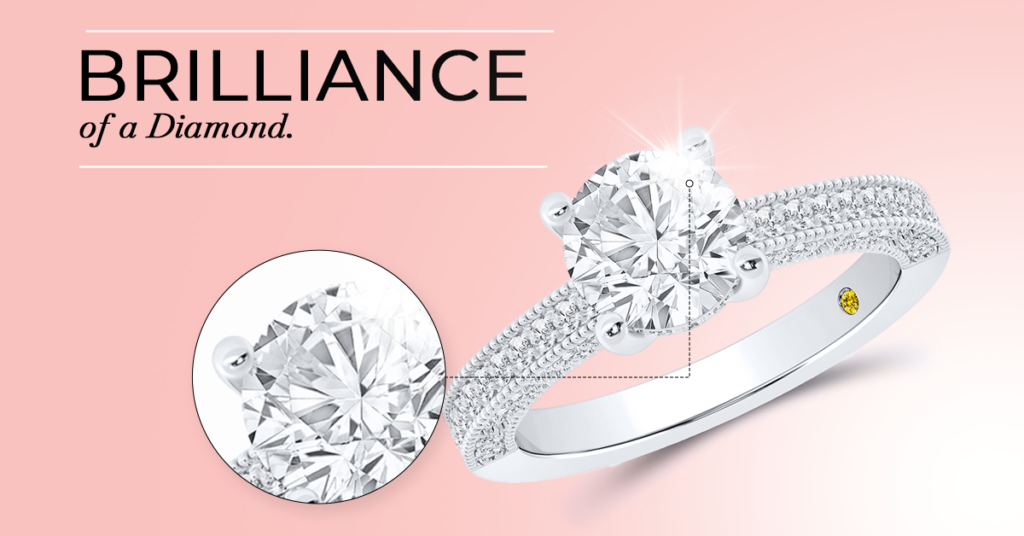
The brilliance of a diamond refers to the white light that’s reflected back to the viewer from a diamond’s surface. A well-cut diamond allows light to enter through the top, reflect off the inner surfaces and return to the eye as an intense, sparkling light which is called the diamonds brilliance.
The amount of brilliance a diamond exhibits is influenced by its cut, symmetry, and polish. A diamond that’s cut too shallow or too deep won’t reflect light properly, reducing its brilliance. Symmetry is also important, as an asymmetrical diamond will have uneven light distribution, resulting in less brilliance.
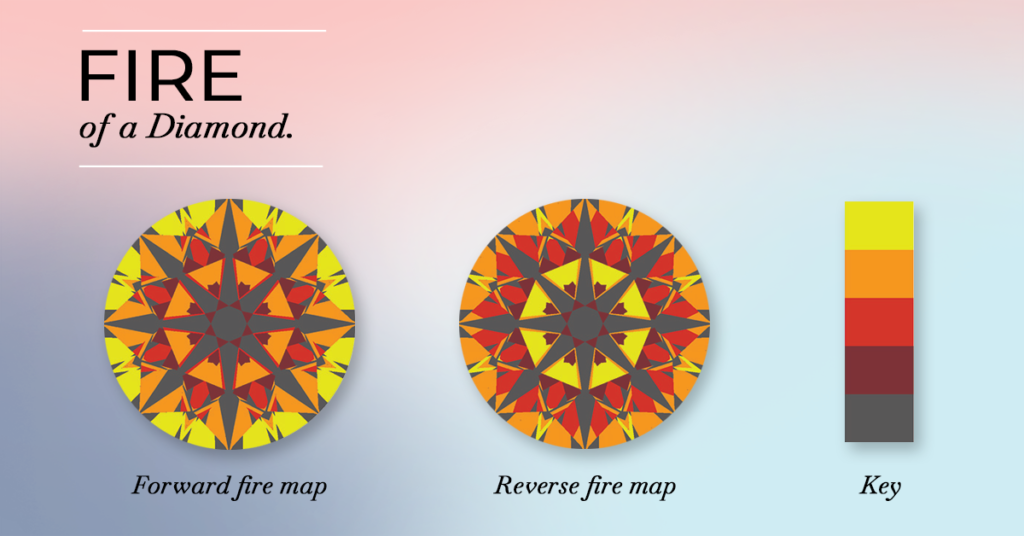
Fire refers to the spectral colours that are produced when light enters and exits a diamond. It’s created when white light is dispersed into its component colours as it passes through the diamond’s facets. The colours are often described as a “rainbow” or “prism” effect.
The amount of fire a diamond exhibits depends on its cut and the angles of its facets. The better a diamond is cut, the more fire it will display. The most common cuts that maximize fire are the round brilliant and princess cuts, which both have a large number of facets that allow for maximum dispersion of light.
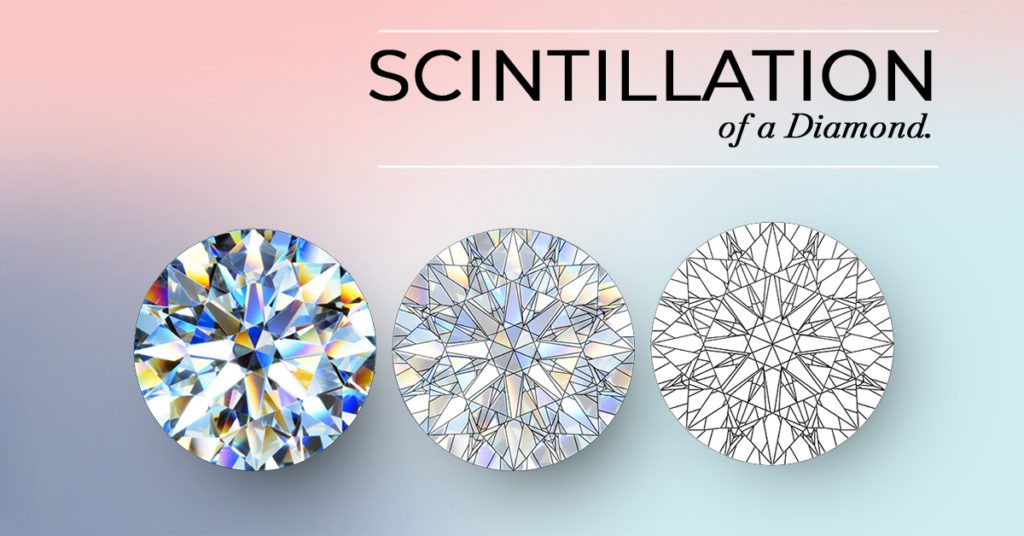
Scintillation is the sparkling effect that is produced when a diamond is moved or when the light source is shifted. It’s caused by the reflection and refraction of light within the diamond. A well-cut diamond will exhibit scintillation when it’s moved, creating a dazzling display of light and shadow.
The amount of scintillation a diamond exhibits is influenced by its cut, symmetry, and polish. A diamond that’s cut too shallow or too deep won’t reflect light properly, reducing its scintillation. Symmetry is also important, as an asymmetrical diamond will have uneven light distribution, resulting in less scintillation.
The quality of the cut is determined by four key characteristics:
1. Depth: This refers to how deep the diamond has been cut, which impacts how much light is reflected back to the eye.
2. Table: This refers to the largest facet on the top of the diamond. The size of the table influences the amount of light that enters and exits the diamond.
3. Symmetry: This refers to how well the diamond has been cut and polished in relation to its axis. The more symmetrical a diamond, the better it will reflect light.
4. Polish: This refers to the quality of the surface of the diamond. A well-polished diamond will allow light to pass through it smoothly, creating more brilliance.
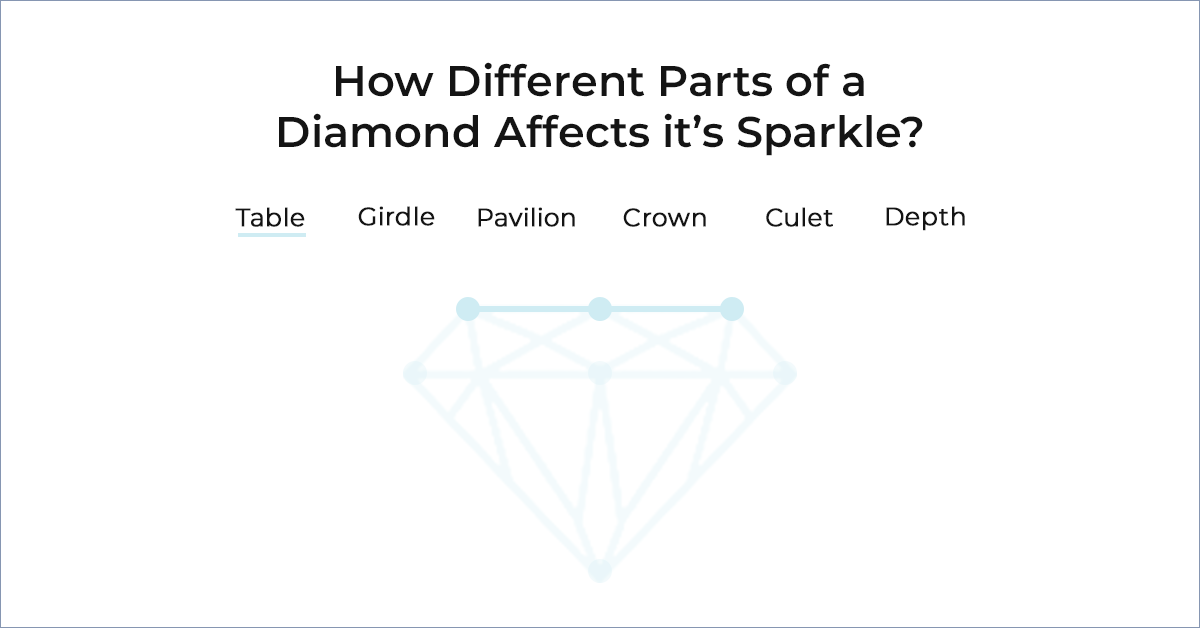
A diamond is made up of several parts, each of which plays a role in its overall appearance and sparkle. Here’s a brief overview of the different parts of a diamond and how they affect its sparkle:
The table is the flat, topmost facet of a diamond. It’s the largest and most visible facet, and it’s responsible for reflecting the most light back to the viewer. A well-proportioned table will result in a brighter and more brilliant diamond.
The girdle is the widest part of the diamond, and it separates the crown (top) from the pavilion (bottom). The thickness of the girdle can affect the diamond’s overall appearance. If it’s too thick, it can add unnecessary weight to the diamond and make it appear smaller. If it’s too thin, it can make the diamond more fragile and increase the risk of chipping.
The pavilion is the bottom part of the diamond, below the girdle. It consists of several facets that come to a point at the culet. A well-cut pavilion will help to maximize the diamond’s fire and scintillation.
The crown is the top part of the diamond, above the girdle. It consists of several facets that lead up to the table. A well-cut crown will help to maximize the diamond’s brilliance and fire.
The culet is the small facet at the very bottom of the diamond. Its purpose is to protect the tip of the diamond from chipping, and to prevent light from escaping through the bottom of the diamond. A well-proportioned culet will help to maximize the diamond’s fire and scintillation.
The depth of the diamond refers to the distance from the table to the culet. It’s an important factor in determining the diamond’s overall appearance and value. If the diamond is too shallow, light will leak out of the sides and the diamond will appear dull. If it’s too deep, light will be lost through the bottom and the diamond will appear dark and lifeless.
In summary, each part of a diamond plays an important role in its overall appearance and sparkle. The size, shape, and proportion of each part can have a significant impact on the diamond’s value and desirability. A well-cut diamond will have a balance of all these factors, resulting in a beautiful and brilliant stone.
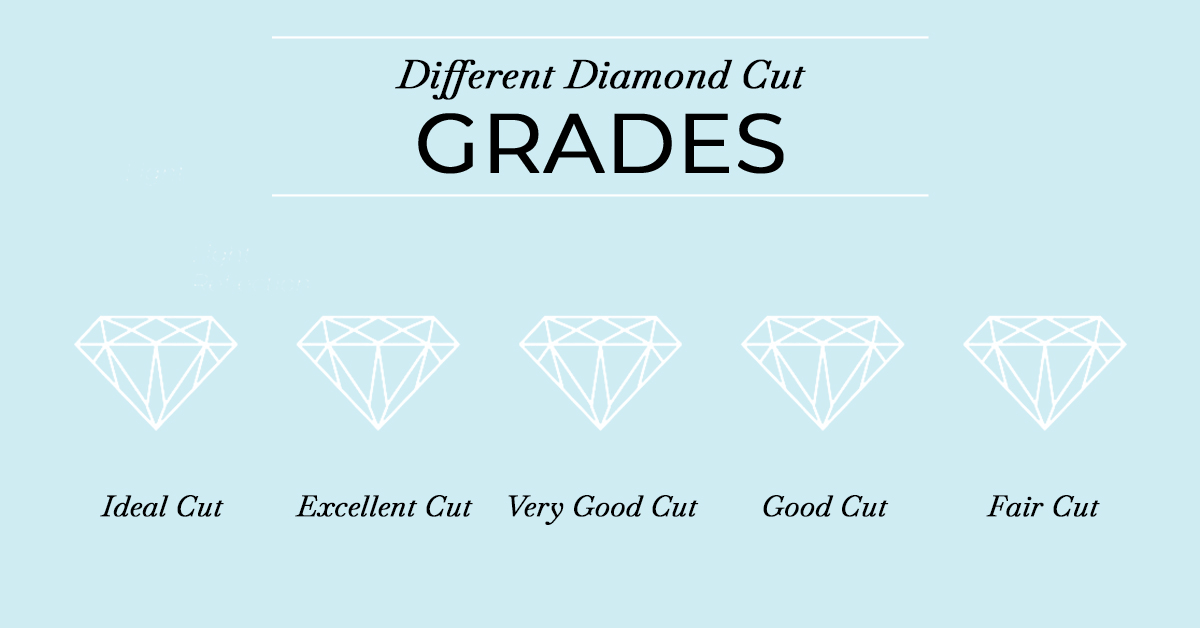
Diamond cuts are graded based on a number of factors, including the proportions and angles of the diamond’s facets. The cut grade of a diamond is an important factor in determining its overall value and beauty. The most common cut grades are Ideal, Excellent, Very Good, Good, and Fair. Let’s take a deep dive into each of these grades to understand their differences and how they impact the diamond’s appearance.
An Ideal cut diamond is cut to the most precise proportions and angles, resulting in maximum fire, brilliance, and scintillation. Ideal cut diamonds have a table percentage of 53-58% and a depth percentage of 58-62.5%. The crown angle is between 34 and 35 degrees, and the pavilion angle is between 40.6 and 41 degrees.
Ideal cut diamonds are rare and highly desirable, and they command the highest prices among all diamond cuts.
An Excellent cut diamond is cut to very precise proportions and angles, resulting in high levels of fire, brilliance, and scintillation. Excellent cut diamonds have a table percentage of 53-63% and a depth percentage of 58-62.5%. The crown angle is between 33.5 and 35.5 degrees, and the pavilion angle is between 40.2 and 41.8 degrees.
Excellent cut diamonds are also highly desirable and command high prices, although they are slightly less expensive than Ideal cut diamonds.
A Very Good cut diamond is cut to precise proportions and angles, resulting in good levels of fire, brilliance, and scintillation. Very Good cut diamonds have a table percentage of 53-64% and a depth percentage of 58-63%. The crown angle is between 32.5 and 36 degrees, and the pavilion angle is between 40 and 42 degrees. Very Good cut diamonds are a good choice for those who want a high-quality diamond at a slightly lower price point than Ideal or Excellent cut diamonds.
A Good cut diamond is cut to good proportions and angles, resulting in decent levels of fire, brilliance, and scintillation. Good cut diamonds have a table percentage of 53-65% and a depth percentage of 59-64%. The crown angle is between 32 and 37 degrees, and the pavilion angle is between 39 and 43 degrees. Good cut diamonds are a good choice for those who are more concerned with the size or color of the diamond than its cut grade.
A Fair cut diamond is cut to less precise proportions and angles, resulting in lower levels of fire, brilliance, and scintillation. Fair cut diamonds have a table percentage of 53-66% and a depth percentage of 59-65%. The crown angle is between 31 and 38 degrees, and the pavilion angle is between 38 and 44 degrees. Fair cut diamonds are the least desirable and command the lowest prices among all diamond cuts.
In summary, the cut grade of a diamond is an important factor in determining its overall value and beauty. Ideal and Excellent cut diamonds are the most desirable and command the highest prices, while Very Good and Good cut diamonds are also high-quality choices at slightly lower price points. Fair cut diamonds are the least desirable and command the lowest prices. When choosing a diamond, it’s important to consider its cut grade in addition to its other characteristics, such as color, clarity, and carat weight.
Absolutely, the cut is considered the most important characteristic of a diamond because it affects the diamond’s overall beauty, brilliance, and value. A well-cut diamond allows light to enter through the top, reflect off the inner surfaces, and return to the eye as an intense, sparkling light. On the other hand, a diamond that is cut too shallow or too deep will not reflect light properly, reducing its brilliance and fire. Therefore, when buying a diamond, it is essential to consider the cut in addition to the other 3Cs (carat weight, color, and clarity) to ensure that you are getting the best value for your money.
Most definitely, a diamond cut makes a difference in the overall appearance and value of a diamond. A well-cut diamond will reflect light in a way that enhances its beauty, while a poorly cut diamond will appear dull and lifeless. The cut of a diamond is one of the “Four Cs” that are used to evaluate the quality and value of a diamond, along with carat weight, color, and clarity. A well-cut diamond can command a higher price than a poorly cut diamond of the same carat weight, color, and clarity. So, it is important to choose a diamond with a good cut to ensure that you are getting the best value for your money.
The cut of a diamond has a significant impact on its value because a well-cut diamond will display a greater amount of brilliance, fire, and scintillation, making it more visually appealing and desirable. In addition, a well-cut diamond will also have better proportions, symmetry, and polish, further enhancing its appeal. Conversely, a poorly cut diamond will appear dull and lifeless, with less sparkle and brilliance. It may also have poor symmetry, uneven facets, and other flaws that can affect its overall appearance and value. So, while the cut is just one of the 4Cs (carat weight, color, clarity, and cut) used to evaluate a diamond’s value, it can have a significant impact on its overall worth.
Certainly, the sparkle of a diamond is greatly affected by its cut. The way a diamond is cut dictates how light passes through it and is reflected back to the viewer’s eye, which has a direct impact on the diamond’s overall sparkle and brightness. When a diamond is cut precisely and in the ideal proportions, it reflects light in a way that enhances its fire, brightness, and scintillation, resulting in a more sparkling look. A badly cut diamond, on the other hand, can appear dull and lifeless, even if it has a high color and clarity grade. As a result, the cut is one of the most important variables influencing a diamond’s overall beauty and value.
The brilliant round cut is widely regarded as the most brilliant of all diamond shapes. This is because it has been precisely created to reflect the most amount of light back to the viewer’s eye, making it shine more than other cuts. Other shapes like the princess cut, cushion cut, and radiant cut, can also be quite brilliant when cut to exact proportions and with good craftsmanship. Finally, the brilliance of a diamond is determined by a variety of characteristics, including cut, clarity, color, and carat weight, and it is critical to evaluate all these elements when assessing a diamond’s overall beauty and worth.
Excellent or Ideal cut diamonds will reflect almost all of the light that goes into the diamond. These diamonds are sparkly and brilliant. Diamonds with a worse cut, such as good, won’t reflect much light out of the top, diminishing their appearance. So this is how you can tell the quality of a diamond cut.
Diamonds are renowned for their ability to transmit light and sparkle so intensely. Diamonds are cut using two main methods: cleaving and sawing. This step gives diamonds their initial shape
Cut is where all of the sparkle and shine comes from! The cut takes into consideration the overall design, craftsmanship and appearance. A well cut diamond is going to have more sparkle, shine and brightness than a poorly cut stone. This is how the ideal cut plays a vital role in.
Shop by metal
Shop by diamond
@ All rights reserved La Joya Jewelry Inc